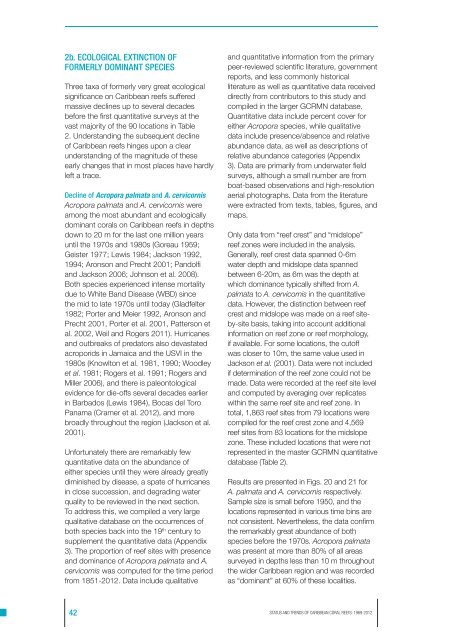Jackson2013-Status and Trendsof Caribbean Coral Reefs
Jackson2013-Status and Trendsof Caribbean Coral Reefs.pdf
Jackson2013-Status and Trendsof Caribbean Coral Reefs.pdf
You also want an ePaper? Increase the reach of your titles
YUMPU automatically turns print PDFs into web optimized ePapers that Google loves.
2b. ECOLOGICAL EXTINCTION OF<br />
FORMERLY DOMINANT SPECIES<br />
Three taxa of formerly very great ecological<br />
significance on <strong>Caribbean</strong> reefs suffered<br />
massive declines up to several decades<br />
before the first quantitative surveys at the<br />
vast majority of the 90 locations in Table<br />
2. Underst<strong>and</strong>ing the subsequent decline<br />
of <strong>Caribbean</strong> reefs hinges upon a clear<br />
underst<strong>and</strong>ing of the magnitude of these<br />
early changes that in most places have hardly<br />
left a trace.<br />
Decline of Acropora palmata <strong>and</strong> A. cervicornis<br />
Acropora palmata <strong>and</strong> A. cervicornis were<br />
among the most abundant <strong>and</strong> ecologically<br />
dominant corals on <strong>Caribbean</strong> reefs in depths<br />
down to 20 m for the last one million years<br />
until the 1970s <strong>and</strong> 1980s (Goreau 1959;<br />
Geister 1977; Lewis 1984; Jackson 1992,<br />
1994; Aronson <strong>and</strong> Precht 2001; P<strong>and</strong>olfi<br />
<strong>and</strong> Jackson 2006; Johnson et al. 2008).<br />
Both species experienced intense mortality<br />
due to White B<strong>and</strong> Disease (WBD) since<br />
the mid to late 1970s until today (Gladfelter<br />
1982; Porter <strong>and</strong> Meier 1992, Aronson <strong>and</strong><br />
Precht 2001, Porter et al. 2001, Patterson et<br />
al. 2002, Weil <strong>and</strong> Rogers 2011). Hurricanes<br />
<strong>and</strong> outbreaks of predators also devastated<br />
acroporids in Jamaica <strong>and</strong> the USVI in the<br />
1980s (Knowlton et al. 1981, 1990; Woodley<br />
et al. 1981; Rogers et al. 1991; Rogers <strong>and</strong><br />
Miller 2006), <strong>and</strong> there is paleontological<br />
evidence for die-offs several decades earlier<br />
in Barbados (Lewis 1984), Bocas del Toro<br />
Panama (Cramer et al. 2012), <strong>and</strong> more<br />
broadly throughout the region (Jackson et al.<br />
2001).<br />
Unfortunately there are remarkably few<br />
quantitative data on the abundance of<br />
either species until they were already greatly<br />
diminished by disease, a spate of hurricanes<br />
in close succession, <strong>and</strong> degrading water<br />
quality to be reviewed in the next section.<br />
To address this, we compiled a very large<br />
qualitative database on the occurrences of<br />
both species back into the 19 th century to<br />
supplement the quantitative data (Appendix<br />
3). The proportion of reef sites with presence<br />
<strong>and</strong> dominance of Acropora palmata <strong>and</strong> A.<br />
cervicornis was computed for the time period<br />
from 1851-2012. Data include qualitative<br />
<strong>and</strong> quantitative information from the primary<br />
peer-reviewed scientific literature, government<br />
reports, <strong>and</strong> less commonly historical<br />
literature as well as quantitative data received<br />
directly from contributors to this study <strong>and</strong><br />
compiled in the larger GCRMN database.<br />
Quantitative data include percent cover for<br />
either Acropora species, while qualitative<br />
data include presence/absence <strong>and</strong> relative<br />
abundance data, as well as descriptions of<br />
relative abundance categories (Appendix<br />
3). Data are primarily from underwater field<br />
surveys, although a small number are from<br />
boat-based observations <strong>and</strong> high-resolution<br />
aerial photographs. Data from the literature<br />
were extracted from texts, tables, figures, <strong>and</strong><br />
maps.<br />
Only data from “reef crest” <strong>and</strong> “midslope”<br />
reef zones were included in the analysis.<br />
Generally, reef crest data spanned 0-6m<br />
water depth <strong>and</strong> midslope data spanned<br />
between 6-20m, as 6m was the depth at<br />
which dominance typically shifted from A.<br />
palmata to A. cervicornis in the quantitative<br />
data. However, the distinction between reef<br />
crest <strong>and</strong> midslope was made on a reef siteby-site<br />
basis, taking into account additional<br />
information on reef zone or reef morphology,<br />
if available. For some locations, the cutoff<br />
was closer to 10m, the same value used in<br />
Jackson et al. (2001). Data were not included<br />
if determination of the reef zone could not be<br />
made. Data were recorded at the reef site level<br />
<strong>and</strong> computed by averaging over replicates<br />
within the same reef site <strong>and</strong> reef zone. In<br />
total, 1,863 reef sites from 79 locations were<br />
compiled for the reef crest zone <strong>and</strong> 4,569<br />
reef sites from 83 locations for the midslope<br />
zone. These included locations that were not<br />
represented in the master GCRMN quantitative<br />
database (Table 2).<br />
Results are presented in Figs. 20 <strong>and</strong> 21 for<br />
A. palmata <strong>and</strong> A. cervicornis respectively.<br />
Sample size is small before 1950, <strong>and</strong> the<br />
locations represented in various time bins are<br />
not consistent. Nevertheless, the data confirm<br />
the remarkably great abundance of both<br />
species before the 1970s. Acropora palmata<br />
was present at more than 80% of all areas<br />
surveyed in depths less than 10 m throughout<br />
the wider <strong>Caribbean</strong> region <strong>and</strong> was recorded<br />
as “dominant” at 60% of these localities.<br />
42 STATUS AND TRENDS OF CARIBBEAN CORAL REEFS: 1969-2012


















